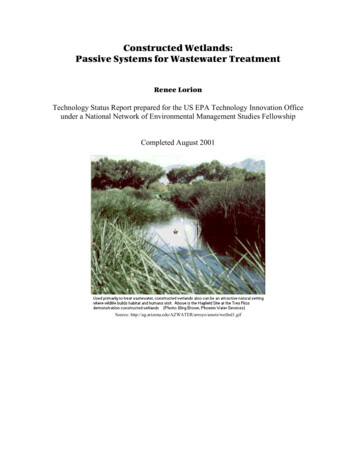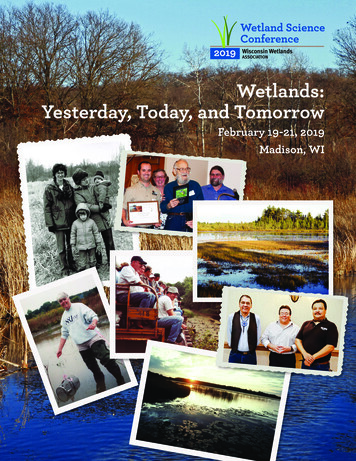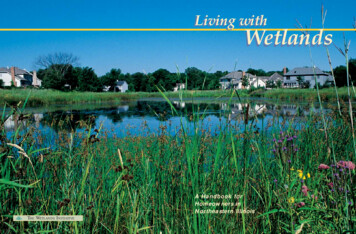
Transcription
Constructed Wetlands:Passive Systems for Wastewater TreatmentRenee LorionTechnology Status Report prepared for the US EPA Technology Innovation Officeunder a National Network of Environmental Management Studies FellowshipCompleted August 2001Source: 1.gifi
NoticeThis document was prepared by a National Network of Environmental Management Studiesgrantee under a fellowship from the U.S. Environmental Protection Agency. This report was notsubject to EPA peer review or technical review. The U.S. EPA makes no warranties, expressedor implied, including without limitation, warranty for completeness, accuracy, or usefulness ofthe information, warranties as to the merchantability, or fitness for a particular purpose.Moreover, the listing of any technology, corporation, company, person, or facility in this reportdoes not constitute endorsement, approval, or recommendation by the U.S. EPA.ii
ForewordConstructed wetlands are an innovative and inexpensive treatment approach that have thepotential to treat organic and inorganic compounds in wastewater from a range of sources.EPA’s Technology Innovation Office (TIO) provided a grant through the National Network forEnvironmental Management Studies (NNEMS) to prepare a technology assessment report on theuse of constructed wetlands for applications other than municipal wastewater. This report wasprepared by a first year graduate student from Washington State University during the summer of2001. It has been reproduced to help provide federal agencies, states, consulting engineeringfirms, private industries, and technology developers with information on the current status of thistechnology.About the National Network for Environmental Management Studies (NNEMS)NNEMS is a comprehensive fellowship program managed by the Environmental EducationDivision of EPA. The purpose of the NNEMS Program is to provide students with practicalresearch opportunities and experiences.Each participating headquarters or regional office develops and sponsors projects for studentresearch. The projects are narrow in scope to allow the student to complete the research byworking full-time during the summer or part-time during the school year. Research fellowshipsare available in Environmental Policy, Regulations and Law; Environmental Management andAdministration; Environmental Science; Public Relations and Communications; and ComputerProgramming and Development.NNEMS fellows receive a stipend determined by the student’s level of education and theduration of the research project. Fellowships are offered to undergraduate and graduate students.Students must meet certain eligibility criteria.About this ReportThis report summarizes the status of constructed wetlands to remove contaminants fromwastewater, and profiles several sites where constructed wetlands have been implemented fortreatment applications other than municipal wastewater. It contains information gathered from arange of currently available sources, including project documents, reports, periodicals, Internetsearches, and personal communication with involved parties. No attempts were made toindependently confirm the resources used.While the original report included color images, this copy is printed in one color. Readers aredirected to the electronic version of this report to view the color images; it is located athttp://clu-in.org.iii
AbstractConstructed wetlands can mimic the filtration processes of natural wetlands,effectively removing contaminants from wastewater. Successful applications for thetreatment of municipal wastewater have led to the exploration of the technology for thetreatment of other wastewater, including industrial, agricultural, acid mine drainage,storm water, landfill leachate, and urban and airport runoff. This paper will summarizethe state of the technology, and profile several sites where constructed wetlands havebeen implemented for treatment applications other than municipal wastewater.iv
Table of ContentsIntroduction.1Design .1Mechanisms for Removal .2Limitations and Considerations .3Conclusions.4Case Studies .5Constructed Wetlands at Milan Army Ammunition Plant, Milan, TN.6Constructed Wetlands at Westover Air Force Reserve Base, Chicopee, MA .8Constructed Wetlands at Iowa Army Ammunition Plant, Middletown, IA .10Fulton Creek Regional Storm Water Management Facility,Edmonton, Alberta, Canada.12Constructed Wetlands at Burleigh Tunnel, Silver Plume, CO.14Bioreactor System at West Fork Mine, MO .16Wetland Remediation System at Elmendorf Air Force Base, AK.18Constructed Wetlands for Perdido Municipal Landfill Leachate, FL.20Constructed Wetlands at Apache Powder Superfund Site, AZ.22References.24v
IntroductionAs they are depleted and affected by development, the importance of naturalwetlands in watershed systems becomes increasingly apparent. Efforts to restore andmaintain wetlands have been crucial to water quality in many areas. A betterunderstanding of the benefits that wetlands provide has led to the use of constructedwetlands to mimic the filtration processes that take place in the fragile ecosystem of anatural wetland. Constructed wetlands have great potential as a clean-up technology for avariety of wastewaters.Constructed wetlands have proven to be a very effective method for the treatmentof municipal wastewater. For a small community with limited funds for expanding orupdating wastewater treatment plants, constructed wetlands are an attractive option.Rural municipalities have access to adequate inexpensive land, and wetlands blend into anatural landscape setting. Once the wetlands are designed and constructed, annualmaintenance costs are low. In addition, wetlands add aesthetic value, and providewildlife habitat and recreation opportunities.The application of constructed wetlands for municipal wastewater treatment hasled to the study of their use for other kinds of wastewater. Acid mine drainage,agricultural wastewater, industrial wastewater, stormwater runoff, landfill leachate andairport runoff are all good candidates for remediation using constructed wetlands. Sitespecific designs that carefully consider factors such as hydrology, native plant species,and seasonal temperature fluctuation can lead to efficient removal of contaminants inwastewater. Demonstration projects have shown that wetlands are effective at removingboth organic and inorganic contaminants. The relatively inexpensive nature of this typeof treatment makes it a potentially cost-effective option for remediation.DesignThe design considerations for constructed wetlands systems are varied and sitedependent1. Municipal wastewater treatment systems are most concerned with thereduction of suspended solids, organic matter, pathogens, phosphates, and ammoniumand organic nitrogen. Other kinds of wastewater treatment wetlands may be concernedwith these same contaminants in addition to other organic compounds, residualexplosives, or metals. Some system designs anticipate exactly what kinds ofcontaminants the wetlands will receive, and at what levels, while others face variable andunpredictable wastewater flows. Some wetland systems treat specific substances, such asairplane deicer fluid. Other systems, such as a stormwater runoff system, may receive amixture of contaminants, with levels of incoming water varying widely with season andyear.Municipal wastewater destined for wetlands treatment often travels through atreatment train, although in some cases wastewater is released directly into a wetlandsystem. The initial step is usually passage through a traditional wastewater treatmentplant, where excess ammonia is removed, followed by a sedimentation chamber where1For further information on wetland design considerations, see the USDA-NRCS, EPA Region III document: AHandbook of Constructed Wetlands: Volume 1 General Considerations.Also see the NFESC document: Constructed Wetland Technology Application Guide, Inception throughImplementation.1
any remaining suspended material is removed. Depending on the levels of fecalcoliforms and the requirements for effluent contaminant levels, the water may bedisinfected with chlorine before release into the constructed wetland system. If the wateris to be discharged into a waterway, the minimum contaminant criteria may be differentthan a system in which the wetlands are the final destination for the water.Engineered wetlands for other kinds of wastewater may also consist of a series oftreatment steps that have been built according to the expected flow and loading rates. Ingeneral, the heavier the load a system receives, the larger the wetlands system will needto be to effectively remove contaminants. The heavier load could be a large volume ofwater discharged into the system, or volumes with higher concentrations of contaminants.A series of lined settling and aeration ponds, or lagoons, may be the initial step intreatment, followed by release into the actual wetland. The wetland designs can varyfrom more traditional systems, with populations of native plants, to aerobic systems thatfunction without aquatic plants and treat waste primarily with added bacteria. An aerobicsystem may use aquatic plants in a final polishing step.Wetlands are constructed as either surface flow or subsurface flow systems.Surface flow systems require more land, but generally are easier to design, construct andmaintain. They consist of shallow basins with emergent and submergent wetland plantsthat tolerate saturated soil and aerobic conditions. Water flows in one end of the basin,moves slowly through, and is released at the other end. These systems provide habitatand public access. Subsurface flow systems consist of an underground flow ofwastewater through some kind of substrate such as gravel. These systems demonstratehigher rates of contaminant removal than surface flow wetlands. The earth providesinsulation for subsurface flow wetlands in cold climates. Subsurface flow systems limithuman and animal exposure, and do not provide habitat for birds, which may be adesirable characteristic for a site such as an airport.Mechanisms for RemovalContaminants are removed from wastewater through several mechanisms.Processes of sedimentation, microbial degradation, precipitation and plant uptake removemost contaminants2. Heavy metals in a wetland system may be sorbed to wetland soil orsediment, or may be chelated or complexed with organic matter. Metals can precipitateout as sulfides and carbonates, or get taken up by plants. Compounds in sediment, suchas iron oxides, show preference for certain metals. This behavior can affect howefficiently a metal is adsorbed in a wetland. A system that has reached the limits of itsadsorption capacity can exhibit a reduction in contaminant removal rates. After a systemhas reached its capacity for metal sorption, metal sulfide formation becomes the mainmethod of metal removal. Sulfate-reducing bacteria oxidize organic matter and reducesulfate to form hydrogen sulfide. Hydrogen sulfide reacts with metals to form metalsulfides, which precipitate. Compared to sediments, plants do not take up much metal,2For further information on fates of contaminants, see Chapter 3 of Constructed Wetlands Treatment of MunicipalWastewater, EPA/625/R-99-010. See also the NFESC document Constructed Wetland Technology ApplicationGuide. A good discussion of the fate of metals is found in Dunbabin and Bowmer, 1992. A good discussion ofsulfide and carbonate precipitation can be found in Gusek, et al. (1998).2
but they are involved in oxygenation and microbiological processes that contribute to theability of the wetland to remove metals.Organic compounds can be broken down for consumption by microorganisms in awetland system. This biodegradation removes the organic compounds from water as theyprovide energy for the organisms. Organics can also be degraded when taken up byplants. They can also sorb to surfaces in the wetland, usually to plant debris. Organiccompounds containing nitrogen sorb to surfaces in the wetland, and organic nitrogen isconverted to ammonia. Ammonia can volatilize, be exchanged with other cations in thesediment, or be nitrified if oxygen is present. Nitrate is the form of N taken up by plants,so emergent plants use it during the growing season. Excess nitrate in an anaerobicsystem is reduced to N2 and N2O gases as a result of denitrification, the main mechanismof nitrate removal.Some wastewaters contain phosphates from cleaning products. Storm water andagricultural wastewater may contain fertilizer runoff containing phosphates. Phosphatescan sorb to surface plants and floating plant litter, as well as to sediment surfaces. Theymay precipitate out of solution with metals at more alkaline pH levels. Soluble inorganicphosphate is taken up by plants, and cycled through their growth and decomposition.Most phosphate is removed from wastewater through sediment retention. Phosphatessorb to sediment surfaces through bonds to positively charged clay particles and bysubstituting for silicate in clay structures.It is not completely understood how explosives are removed in a wetland system.Wastewaters contaminated with compounds such as RDX3 have been successfully treatedby constructed wetlands. It is suspected that several processes working in conjunctioncontribute to their degradation. Enzymes reduce nitro groups to amino groups in someexplosives, such as TNT. Nitro groups in RDX are reduced to nitroso groups byenzymes. These compounds are broken down further by ring cleavage. Degradation alsooccurs in plants that take up the compounds.Limitations and ConsiderationsMany factors affect the ability of a constructed wetland to effectively removecontaminants. Temperature and fluctuations in flow affect wetland function and cancause a wetland to display inconsistent contaminant removal rates. Colder conditionsslow the rate at which the wetland is able break down contaminants. A heavy flow ofincoming water can overload the removal mechanisms in a wetland, while a dry spell candamage plants and severely limit wetland function. Using designs that consider thesefactors, wetlands have been successfully implemented in a variety of climates.A constructed wetland treating wastewater that contains contaminants such asmetals or residual explosives must be monitored for contaminant buildup. Some wetlandsystems for acid mine drainage treatment use a compost or peat lining. Metal precipitatescan build up in the compost, peat, or sediment, causing these layers to become nonpermeable. It may be necessary to dredge the contaminated substrate after it has reachedsaturation. In some aerobic systems that utilize added bacteria, alcohol is added to feedthe microorganisms rather than organic compost. This method avoids contaminant buildup problems in the sediment.3Royal demolition explosive or research department explosive, hexahydro-1,3,5-trinitro-1,3,5-triazine3
Testing effluent water from a wetland system is necessary, as the goal of thedesign is to remove contaminants. Water cannot be discharged into waterways if it doesnot meet standards. In some cases, the constructed wetlands act as holding ponds forstorm water overflow, preventing floods. The water is then discharged into the naturalwatershed over time. Wetlands are often constructed adjacent to an existing stream orcreek, some of which are heavily polluted from years of receiving contaminated water.Clean discharge into these waterways is a crucial component to their restoration. Otherconstructed wetlands may be the final destination of wastewater, which will eitherevaporate or seep into the groundwater.Other considerations that may affect the feasibility of a constructed wetlandapplication include the availability of suitable land. In sites with steep slopes, it may notbe economically practical to excavate an area and reinforce it with retaining walls. Soiltype, vegetation, and high contamination levels in soil or water may make a siteunsuitable for wetland construction. Issues such as mosquitoes and odor can arise, butcan be avoided with careful planning. The long-term effects of contaminant exposure onwildlife and vegetation are not fully understood. Studies of ecological risk andbioaccumulation are still needed4.ConclusionsConstructed wetlands have a great potential for contaminated wastewatertreatment. With careful design and planning, a constructed wetland can efficientlyremove a variety of contaminants. The cost for design, construction and implementationcan be considerably lower than other wastewater treatment options. The following set ofcase studies demonstrates the range of sites where this technology has been successfullyapplied.4See Canfield, et. al., an ecological risk study in progress.4
CASE STUDIESAriel view of the Apache Nitrogen Products Wetland Project. http://www.hargis.com/awp/indexawp.htm5
Constructed Wetlands at Milan ArmyAmmunition Plant, Milan, TennesseeWastewater: Explosiveresidues in groundwater,TNT, RDX, HMX,2ADNT, 4ADNTImplementation Date:1996-1998Status:Demonstration completeContact:Darlene Bader(410) 436-6861dfbader@aec.apgea.army.milCERCLA Site EPA ID:TN0210020582Groundwater contaminated with residual explosiveswas treated using constructed wetlands. Asubsurface flow wetland and a surface flow wetlandwere constructed and compared. The subsurfacewetland demonstrated a higher proficiency forcontaminant removal.Site HistoryMilan Army Ammunition Plant was constructedduring World War II. The plant produced, stored,transported and packed ammunition. Thewastewater from production facilities wasdischarged into open ditches that drained intonearby streams until 1981. Contaminants fromdischarged water in the drainage ditches leachedinto the groundwater. Water sampling of nearbyresidential and public water supply wells indicatedthe presence of contaminantsWetland ApplicationTwo demonstration wetlands were constructed, asurface flow, or lagoon, wetland and a subsurfaceflow or gravel-based wetland. The subsurface flowwetland consisted of two cells in series, four feetdeep and populated by emergent plants. A carbonsource was added to the first cell to maintainanaerobic conditions. The second cell wasmaintained at aerobic conditions. Water wasretained in the 0.088-acre anaerobic cell for eightdays, and in the 0.030-acre aerobic cell for twodays. The anaerobic cell was designed to degradethe explosives, while the aerobic cell was designedto treat by-products of degradation, biologicaloxygen demand, nutrients, and total suspendedsolids. The surface flow wetland was comprised oftwo lagoons in series. These wetlands were twofeet deep and populated by submergent plants.ResultsThe subsurface flow wetland met demonstrationgoals of 50 ppb of total nitrobodies except during6
periods of very low temperature. Further studyindicates that a full-scale system with greaterretention times would perform even during wintermonths. Goals of 2 ppb of TNT were also met formost of the demonstration, except for a short periodwhen data was not collected to due to equipmentfailure. The surface flow wetland was unable tomeet the total nitrobody-removal goals, and met theTNT removal goal for only the first 50 days of thedemonstration. The surface flow wetlandexperienced a tadpole infestation that damagedplants in the initial stages of the demonstration, andadequate plant growth was not reestablished. Ahailstorm later damaged the remaining plants. Thesurface flow wetland was not evaluated in a costperformance study. The subsurface flow wetlandwas found to be a cost effective and efficient systemfor the remediation of explosives.Site References:ESTCP. 1999. The Use of Constructed Wetlands toPhytoremediate Explosives-ContaminatedGroundwater at the Milan Army Ammunition Plant,Milan, Tennesee.Federal Remediation Technologies Roundtableonline 4.html7
Constructed Wetlands at Westover AirForce Reserve Base, Chicopee, MAWastewater: Aircraftdeicing fluid runoff. Fluidcontains primarilypropylene glycol, as well asand ethylene glycol,wetting agents, and anticorrosion agents(Methylbenzotriazole).Implementation Date:Construction planned forfall of 2001Status:Contracting stageContact:Jeff Karrh, P.I.NFESC, ESC411(850) 982-1272karrhjd@nfesc.navy.milThe Westover Air Force Reserve Base is in theprocess of building a demonstration sub-surfaceflow wetland to treat aircraft deicing fluid runoff.The wetland will serve as a study in design,construction and implementation to establish amodel for future DoD applications.Site HistoryThe base is an active Air Force Reserve base,opened in 1940. At that time it was the largest airforce base in the United States. It housed manydifferent divisions of the Air Force until 1974, whenjurisdiction of the base was transferred to the AirForce Reserve. It is home to the 439th Airlift Wing,as well as to tenant organizations such as the USMarine Corps Reserves and the MassachusettsArmy National Guard. Two active runways existon the base. Deicing activities for aircraft andrunways occur every winter. The amount of deicingfluid used varies with the severity of winterweather. Precautions are taken to reduce theamount of fluid that is released into theenvironment, but some release is inevitable.Deicing fluid that enters the storm sewer system cancause adjacent surface waters to becomecontaminated. Other US airports have experiencedproblems with this contamination resulting in fishkills downstream.Wetland ApplicationA horizontal subsurface flow wetland will beconstructed to treat aircraft deicing fluid. Thesubsurface model was chosen to eliminate odors, toefficiently treat contaminants in a small area, and toprevent an increase in bird air strikes. This type ofwetland does not provide habitat for birds, whichare undesirable near a runway. The proposal is tobuild one or two subsurface flow cells, with a totalarea between 0.5 and 1 acre. The runoff fromdeicing operations on the East ramp is piped into8
an oil/water separator, and flow from the separatorwill be piped to the wetland cells. Water willbe released through an outfall into Cooley Brook,which flows to the Chicopee Reservoir and River.ResultsThe purpose of the project is to demonstrate howconstructed wetlands might be implemented at otherDoD sites to treat deicing fluid runoff. Extensiveinitial sampling is still taking place to establishaccurate baseline levels of contaminants in surfacewater in the area. Goals for the wetland includereduction in biochemical oxygen demand levels,which increase with additions of propylene glycol.Monitoring for BOD5 will allow for evaluation ofwetland efficiency at removing propylene glycol.The goal will be to achieve average levels of BOD5 30 mg/L. Other goals of this wetland projectinclude implementing a low cost, low maintenancemethod of deicing fluid runoff treatment that willimprove deicing logistics and flight scheduling,without creating odors or increasing bird air strikes.Site References:ESTCP Website cfmKarrh, J., Knight, R., Cancilla, D., Hernandez, M.ESTCP. 2001. Demonstration Plan: Westover AirReserve Base, Chicopee, MA. Revised Draft-FinalDocument.9
Constructed Wetlands at Iowa ArmyAmmunition Plant, Middletown, IowaWastewater: Surface andgroundwater with residualexplosives, RDX (RoyalDemolition mplementation Date:1998Status:OngoingContact:Donald D. MosesUSACE Omaha District(402) 221-3077Donald.d.moses@Usace.army.milCERCLA Site EPA ID:IA7213820445The Iowa Army Ammunition Plant in Middletown,Iowa treated surface and groundwater contaminatedwith explosives using full-scale constructedwetlands. The wetlands reduced RDXconcentrations in wastewater to non-detectablelevels throughout the first two years of operation.Site HistoryThe plant has been in operation since 1941, loading,assembling and packing ammunition. Dischargefrom these activities caused nearby Brush Creek toflow red with explosives and explosive by-products.A lagoon, the Line 800 Pinkwater Lagoon, wasconstructed in 1943 to hold contaminatedwastewater. An earthen embankment called theLine 1 Pinkwater Impoundment was constructed toimpound wastewater in 1948. These two areas werethe greatest sources of contamination, with drainagedirectly into Brush Creek.Wetland ApplicationSoils from both the lagoon and the impoundmentwere excavated and transferred to a landfill. Theexcavated areas became the sites for the engineeredwetlands, which were designed to treat residualexplosives in the soil and contaminatedgroundwater. The 5.5-acre lagoon wetland waslined with sediment from a nearby lake for aseedbank, and filled with water from surface runoffand groundwater infiltration. The 3-acreimpoundment site wetland was lined with sedimentfrom the upper reaches of the impoundment area aswell as with sediment from the lake to establishemergent and submergent plant species. Bothwetlands have pipe structures to regulate the waterlevel. The impoundment wetland has an upperhydraulic control structure that can be used to divertBrush Creek into the impoundment.10
ResultsDuring the 1998 and 1999 growing seasons, surfacewater, sediments and plant tissues were carefullymonitored. The transferred seedbed was asuccessful means of establishing a diversecommunity of local plant species. Plant tissuesampling at three times during the growing seasonshowed non-detectable levels of explosives.Sediment sampling in both wetlands showed thatremediation goals had been met, explosive levelswere reduced to below 1.3ppm for RDX in all butone area. Surface water was monitored monthly. Agreat reduction in RDX levels was seen during thefirst growing season, with a slight increaseoccurring during the winter. The second growingseason showed further reduction, to almost nondetectable levels, with another slight increase overthe cold season. Projections are that reductions willcontinue until levels are non-detectable year round.Overall ecological monitoring will continue, toassess the contaminant buildup risk to plant andanimal populations.Site References:Kiker, J.H., Larson, S., Moses, D.D., Sellers, R.2001. Use of Engineered Wetlands toPhytoremediate Explosives Contaminated SurfaceWater at the Iowa Army Ammunition Plant,Middletown, Iowa. Proceedings of the 2001International Containment and RemediationTechnology Conference and Exhibition.11
Fulton Creek Regional Storm WaterManagement Facility, Edmonton, AlbertaWastewater: Storm waterrunoffImplementation 6kuehneh@edmonton.associated-eng.comThe need for a storm water management system wasrecognized, as was the need for fill for an adjacentfreeway expansion. The excavation area wasutilized as a constructed wetland, creating a stormwater holding facility that would reduce floodingdownstream and improve storm water runoff qualitywhile attracting wildlife and recreation.Site HistoryThe city of Edmonton, expecting continued growthin the area around Whitemud Drive between 34Street and Highway 14, wanted to expandWhitemud Drive from four lanes to six. This actionrequired a large amount of fill. In addition to thefreeway runoff, it was expected that the watershedin this area would be affected by increasingresidential and industrial development. It wasdesirable to find a solution for storm watermanagement that was cost efficient and wouldprevent Fulton Creek from flooding downstream.Creating a wetland in the area excavated to providethe highway fill met these needs. It would providesufficient storm water storage capacity, as well ashigher quality runoff and wildlife habitat.Expansion of the area was considered in theplanning stages, and the facility was designed tohandle the impacts of runoff from futuredevelopment.Wetland ApplicationA 55-acre wetland was created adjacent to thehighway. Computer modeling was used toanticipate storm water loads based on historicalstorm frequency and severity. The system wasequipped with a piping system with receiving andoutlet structures to control rates of releasedownstream. Rapid drawdown capability wasincluded in the design to prevent downstreamflooding due to severe storms or the occurrence ofstorms in rapid succession. The goal was to create12
an area that was not uniform to attract diverse plantsand wildlife. Vegetation was strategically plantedat different levels along the shoreline to reflectpotential flooding and expected water levelfluctuation. Low and high marsh areas werecreated, to promote a variety of submerged plants.Islands were formed for waterfowl nesting areasaway from humans and predato
unpredictable wastewater flows. Some wetland systems treat specific substances, such as airplane deicer fluid. Other systems, such as a stormwater runoff system, may receive a mixture of contaminants, with levels of incoming water varying widely with season and year. Municipal wastewater destined for wetlands treatment often travels through a










